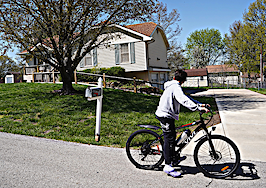In these times, double down — on your skills, on your knowledge, on you. Join us Aug. 8-10 at Inman Connect Las Vegas to lean into the shift and learn from the best. Get your ticket now for the best price.
One year after the overturn of Roe v. Wade, impact headlines steadily flow in — in the form of personal stories, statistics and heated debates. In our previous coverage, we tackled the sentiment that folks would move, but other readers pushed back that people would move to like-minded states.
Still, others argued that the majority of America did not want this, that it is a loud majority who pushed for this overturn. We aimed to understand the impact, but the impact was swift, taking place in hospitals and doctors’ offices in rural towns and in many cases, at kitchen tables wondering what to do next.
What we are dealing with now is collateral damage.
What was said last year
Our previous coverage tackled all angles, including our readers’ opinions. Many of the states that activated the bans had laws previously written that were already in place, which is why the overturn was so swift. The potential has been there, in some cases, for decades.
- Roe v. Wade has been overturned. What does it mean for real estate?
- Abortion policies are a dealbreaker for 27% of movers: Redfin
- The real estate companies offering support in the wake of Roe v. Wade
- Inman survey: Readers weigh in on the potential impact of the Roe v. Wade decision
What’s changed?
Most obviously, the change in law creates a system by design that will create more humans. Those humans will need care, specialized nutrition, daycare services, education, medical care and housing.

Source: Myers Abortion Facility Database. Travel distances are calculated from a county’s population center, as defined by the U.S. Census Bureau, to the nearest facility providing abortions.
- We do not know officially yet if this will impact an already overstrained social service system that manages low-income families with subsidized daycare, food, subsidized housing and foster care services.
- We know that many people have become very serious about family planning. That means they are taking additional measures to ensure that they don’t add any unexpected family to their plan.
- Since last year’s overturn, there has been a reported 35 percent increase in vasectomies and an estimated 41 percent increase in IUD birth control methods.
- We know that maternal mortality rates are on the rise.
- The numbers do not lie. The majority of states that have banned abortion care and services also have a terrible track record for caring for mothers and infants, to begin with.
Maternal death rates were 62 percent higher in 2020 in abortion-restriction states than in abortion-access states (28.8 vs. 17.8 per 100,000 births)- The Common Wealth Fund
- More recently, the White House has stepped up efforts to ensure Americans have more access to contraception and support programs in a third executive order since the bans have taken place.
- We know that the wealth gap in receiving healthcare has widened. Those with financial means will still seek out care.

This map details which areas in our country do not easily assess pregnancy and maternal medical care and delivery services.
- Low-income individuals will have limited choices. Not only do families have to travel for regular maternal care, but, if complications arise, that care is further than ever before. For example, if they cannot afford to travel to a state to receive care, they may be forced to wait out their medical issues until it becomes urgently life-threatening or it may just further create a strain on their financial footprint.
Affordable housing and health care are tangled together

Data: HUD, World Population Review
Source: Homebuyer.com
Studies have shown that individuals who are and become homeowners have many health benefits. For decades, there has been a huge push to paint the picture of happy, healthy people building generational wealth as homeowners.
Homeownership for low-income to, now, even moderate-income families is filled with challenges. Not only do they need to have better credit scores, low debt and some reserves in place to cover starting expenses, they also need resources to maintain the home and pay ever-rising utilities.
In traditionally affordable places to live, you are looking to make compromises. You probably have to commute to work if you want a higher-paying job. There is probably limited or over-capacity infrastructure and overcrowded school districts.
Let’s use Alabama as an example:
- Ranked No. 11 for affordable housing in 2023
- In Alabama, there are 620 bridges and over 2,961 miles of highway in poor condition
- They have approximately 6,000 children in need of a home in foster care
- Ranks No. 5 in “healthcare desert,” meaning that many residents have to drive long distances to receive all types of healthcare services
- Ranks 46th in education
- Ranks No. 3 for high maternal mortality rates (2020). After an investigation into the deaths reported, 75 percent were found to be preventable.
- It costs $15,162, on average, to give birth in an Alabama hospital.
Women who are giving voice to their collateral damage
One year later isn’t enough time to measure significant statistics, but we have multiple stories of families and, more importantly, mothers who have been victims of these enforced laws.
The stories linked below are about women wanting to have children but they experienced a failure of quality care from the states they call home. This is what these bans look like.
The damage these women experienced is measurable. The damage is significant. The trauma they experienced could impact their families for generations. They could sue for not receiving appropriate medical care if this was for any other illness.
- Elizabeth Weller never dreamed that her own hopes for a child would become ensnared in the web of Texas abortion law.
- Deborah Dorbert’s son, Milo, died in her arms on March 3, shortly after he was born, just as her doctors had predicted he would.
- Dani Rios was 20 weeks and three days pregnant when she learned her water had broken early. The chances of the baby surviving were very low, but she couldn’t end the pregnancy under Texas laws.
- Samantha Casiano, knew their baby wouldn’t survive long because she had anencephaly – part of Halo’s brain and skull never developed.
- Kelly Shannon learned she was pregnant at the end of last year, but testing revealed that the fetus had swelling in its head and body, a heart defect, and a growing tumor that was already a third of the size of the fetus.
- Tara George’s OB-GYN told her that if she tried to carry the baby to term, she could become dangerously ill or suffer a blood clot that could threaten her life.
First, Do no harm
I have spoken to many women this past year. I have had many conversations that are sad, frustrated, and angry, and then, surprisingly, some women feel that the collateral damage is so small that they are not bothered by the change.
Some women are happy, and they agree with the laws. The laws align with their religious beliefs, and they feel a wrong has been righted in society. They care about life; they care about children. They prayed for this.
One conversation I had was from the perspective that the scenarios that turn into emergency scenarios are so few that they would continue to vote to support the abortion ban because it didn’t amount to much change at all. They preferred to stay with their main political party agenda.
Whether you are brave enough to talk about it or not, I can tell you one thing. You have thought about it. You have weighed your options personally and think you know what you would do.
How many of us have calculated how many miles we would have to drive, how much money we would have to save, or how dangerous it would be to take a friend, sister or daughter? Just in case.
How many women now have had to research family planning alternatives or IVF services a game plan if things go sideways?
The business of having children is messy. Even if you want children, the biology of nature doesn’t care what rules our governing bodies create. Nature has a way of doing what it wants, and, often, it doesn’t care about the morals and plans of society.
But let’s talk about housing; let’s talk about the “American Dream.” People, policy and a place to call home. Everyone wants to discuss how abortion makes them feel, but feelings are not facts.
What does it mean when your home, your state, puts your wife, sister, daughter and friend in mortal danger? One year later, it’s hard to measure when I think about where things are and where things are going. But one thing seems certain; we seem to be going backward in all the wrong ways.
Rachael Hite is a former agent, a business development specialist, fair housing advocate, copy editor, and is currently perfecting her long game selling homes in a retirement community in Northern Virginia. You can connect with her about life, marketing, and business on Instagram.













